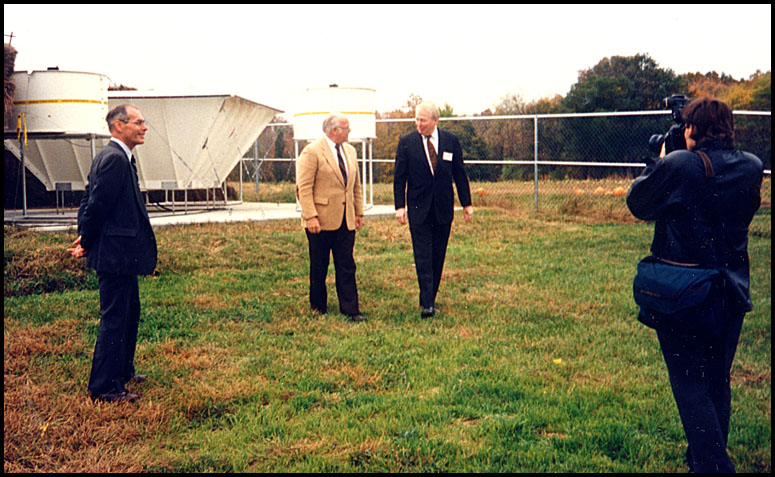The PAM Site's Origins
The Rutgers PAM Site is the United States' first and oldest permanent comprehensive photochemical assessment monitoring station, and has been in continuous official operation since October 1, 1994. The station's story begins with 1993 Congressional Regulations stemming from the Clean Air Act of 1990 that called for these PAMS installations to be completed in places all over the country where problems with smog, ozone, and other health hazards existed. For New Jersey, this meant building and designing one of these stations in a centralized spot in the state. After looking into several possible locations, NJDEP, Rutgers, and EPA officials all agreed that this spot on Rutgers Horticulture Farm 3 was the perfect location. This was also partially due to a seasonal pollutant installation not far from the farm had recently recorded one of the highest summer ozone values the state had seen. The farm land the site is on was, and still is, graciously rented from the Department of Plant Biology and Pathology.
A Group Effort
It takes a lot of effort to assemble almost a half-million dollars to build a site, but thanks to a dedicated group, the site was able to push forward towards development. Dr. Nathan Reiss, then professor of Meteorology and department Chair at Cook College (renamed the Rutgers School of Environmental and Biological Sciences in 2007), was the major overseer of the construction and implementation of the site on the Rutgers side of things. Many groups, both public and private, contributed to the site during its construction due to a strong interest in the sites capability. Financial and consultative contributions to the site came from PSE&G, JCP&L, the EPA, NJDEP, and Rutgers University itself. Interest from PSE&G and JCP&L came because at the time, New Jersey was a very large power-generating fossil fuel emitter, and viewed the site as a vital tool to study pollution concentrations, as well as to influence their decisions in the buying, selling, and trading of emissions credits. (While NJ has now become a leader in clean energy production, the upper air profiler at the site is capable of measuring winds exceeding 1km high, data that may prove helpful to power companies for assessing outages related to large-scale wind events (hurricanes, Nor'Easters, etc) that pass through our area.)
Construction of the Site
Construction began on the site late in 1993, and went solidly through the summer of 1994. Tireless efforts by Dr. Reiss and Rutgers, and by various construction crews and NJDEP/EPA officials saw the rapid transformation of a benign tract of farmland evolve into a cutting edge atmospheric research site.
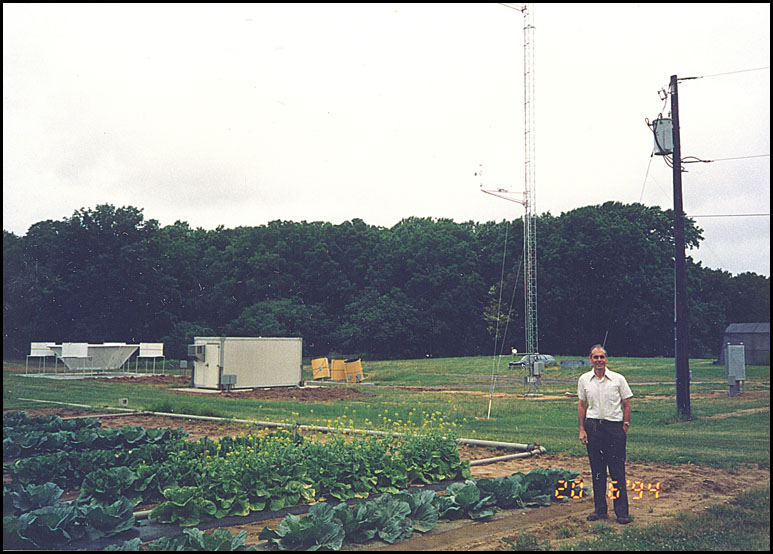
The PAM Site nearing completion - 6/20/1994. Photo courtesy of Dr. Nathan Reiss (pictured right).
By the end of the summer, the equipment had been installed, the trailer had been placed by the NJDEP, and the site was ready to go. It was decided that a formal ceremony would be held to celebrate the opening of the new research station.
Site Completion
The site officially started recording data on October 1, 1994. Later in the month on October 25th, a formal ceremony and equipment demonstration was held.
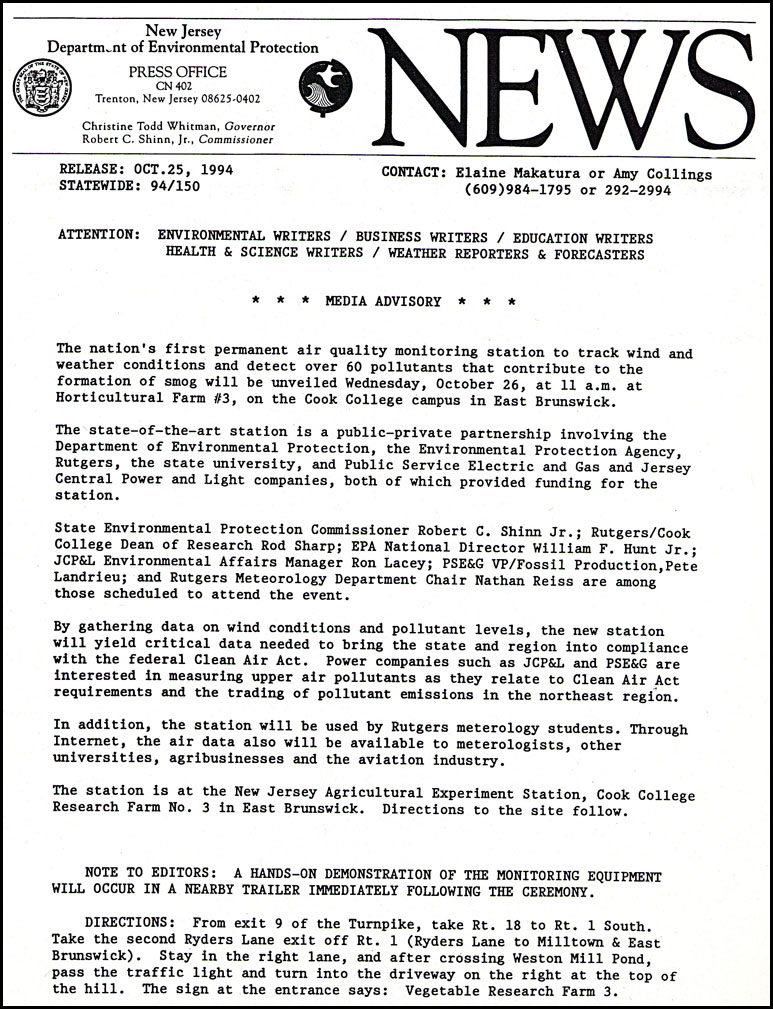
The original press advisory issued to local media outlets about the unveiling of the site. Article courtesy of Dr. Nathan Reiss
During the ceremony, many different people came to see the site and hear about what had been built. Included were Dr. Reiss himself, National EPA Director William F. Hunt Jr., Cook College Dean of Research Rod Sharp, NJDEP Commissioner Robert Shinn, Vice President of PSE&G/Fossil Production Pete Landreiu, then-professor and future chair of Rutgers DES and current Dean of the Rosenstiel School of Marine and Atmospheric Science at the University of Miami Dr. Roni Avissar, as well as many other distinguished guests.
Nat Reiss with NJDEP Commissioner Robert Shinn and Cook College Dean of Research Rod Sharp walking around by the wind profiler - 10/25/1994. Photo courtesy of Dr. Nathan Reiss

Another view of the group posing for photos during the opening ceremony - 10/25/1994. Photo courtesy of Dr. Nathan Reiss
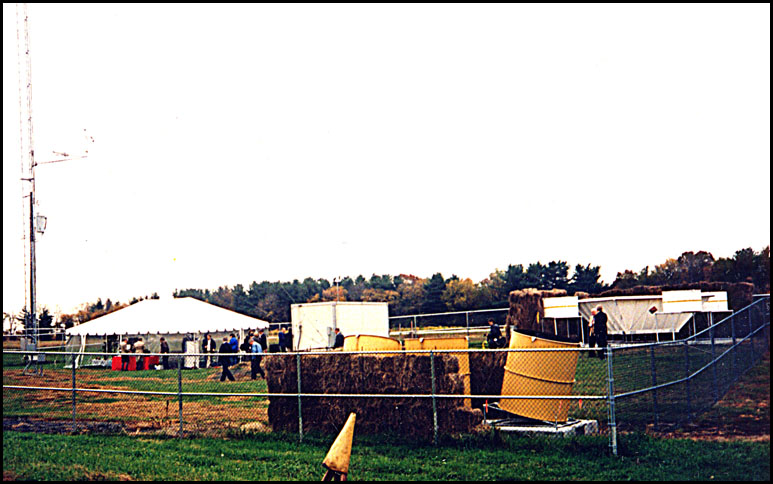
Overview of the site the day of the ceremony - 10/25/1994. Photo courtesy of Dr. Nathan Reiss

Visitors having a look around the site and Research Farm - 10/25/1994. Photo courtesy of Dr. Nathan Reiss
Having seen the press advisory, the local media was also in attendance. The opening of the site also made the front page of the local newspaper, The Star Ledger. It also made headlines in the Daily Targum and Rutgers Focus (article below).
***To read all of the articles including the Official Rutgers University Press Release regarding the PAM Site unveiling, please visit the Publications section of our website.***
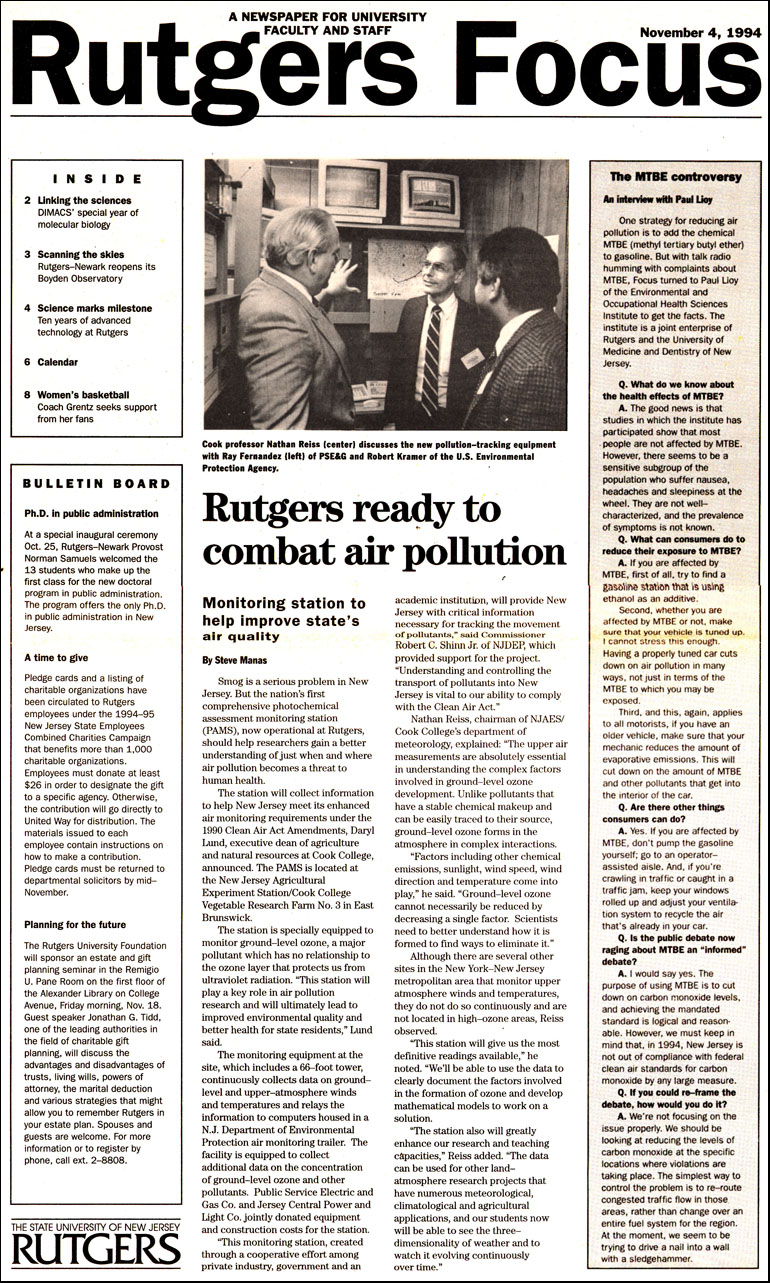
Image of the Front Page of the Rutgers University Focus - 11/4/1994. Article courtesy of Dr. Nathan Reiss
From there, the site fell into a daily routine of data acquisition. There was one notable 'speed bump' along the way with the site, however.
An Unexpected Meeting with the Neighbors
As discussed in the equipment section further down on this page, the RASS part of the wind profiler does emit a rather high level of audible noise for the 5 minutes per hour it runs. The SODAR also used to give off audible noise too. Shortly after the equipment was up and running, Dr. Nathan Reiss received a phone call from then State Assemblywoman Barbara Buono stating that a family adjacent to the farm had contacted her about the noise from the site! After a meeting with Asw. Buono, the family, NJAES Associate Director Dan Rossi, and Dr. Reiss, an agreement was struck that the audible portion of the equipment would only be run during the day, and that hay bales would be placed to help to muffle the sound.

Photo taken during the PAM Site Opening Ceremony. ***NOTE the hay bales installed in the direction of the houses across from the farm - 10/25/1994. Photo courtesy of Dr. Nathan Reiss
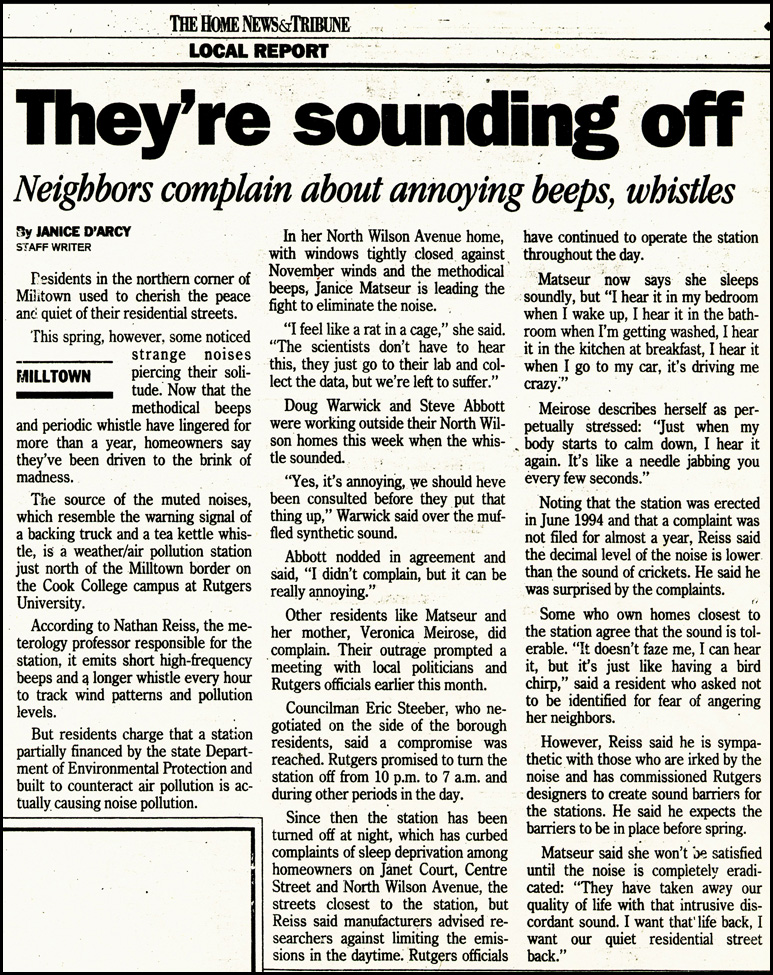
Article from the Home News Tribune telling the story of the neighbors' less than friendly complaints -- Fall 1995. Courtesy of Dr. Nathan Reiss
Fortunately, since this initial complaint, there have been no additional formal complaints about the noise. While the hay bales at the site are long gone, it's possible that either people seem to have just gotten used to the distant noise, or it has further been muffled by the fact that there is now a thick stand of trees that line the farm's border with Ryders Ln. and the houses. Either way, a peaceful coexistence is now maintained between the site and the locals.
1990's and into the 2000's
Throughout much of the late 90's and 2000's, the site remained pretty much unchanged. The station built up an impressive data archive, with a nearly complete record of data for the equipment at the site spanning over the next decade and a half. When Dr. Reiss retired in the late 1990's, Dr. Barbara Turpin took over the site, and continued to keep the site going with routine maintenance of the equipment, and continued archiving and quality controlling of the data.
By the late 2000's, however, the once state-of-the-art equipment at the site began to show signs of its age, but with the cunning ingenuity of site technician Bob Porcja, the site continued on with an impressive reliability well past some of the expected lifetimes of the components at the site.
A Rebirth
After spending over a decade as a research scientist at Brookhaven National Laboratory, Dr. Mark Miller came to Rutgers University in 2007 to study cloud physics and become the head of the Meteorology Graduate Student Program. In late 2011, Mark was offered the opportunity to inherit the now out-dated PAM Site, in hopes of providing it with some TLC and necessary upgrades. Starting in the summer of 2012, Mark began employing Rutgers Atmospheric Sciences graduate student Matthew Drews to assist in working at the site to evaluate and understand the setup at the site, organize and sort through the nearly 20 years worth of data, and determine what needed to be done there in what order of priority.

